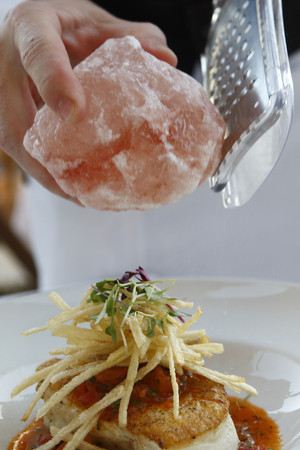SALT SHAKER

The next time you reach for a salt shaker to season a grilled steak or sauteed fish fillet, think about how much more interesting that food could be if you used something other than plain old table salt.
There’s smoked salt, for example. Salts with various herbs and spices. Even salt with activated charcoal. There are so many different types — and types within types — that the best thing to do is experiment until you find a combination you like.
At Nora’s Wine Bar & Osteria at 1031 S. Rampart Blvd., chef and co-owner Giovanni Mauro — a self-described “salt freak” — said there always are three types of salt on his tables. While they change now and then, right now there’s Malden from Essex in Great Britain; a pink salt from the Murray River in Australia; and Salish, an alderwood-smoked salt from Oregon.
The Malden and Murray River salts both have sort of flaky textures, Mauro said; “the second it touches a liquid, it just melts into the food.”
But the similarity ends there. Mauro said the Malden salt has more of an ocean flavor from the waters of the North Sea, where it’s been harvested naturally for hundreds of years. “The flavor is a little bit more intense on that one because of where it comes from,” he said.
The pink Murray River salt, he said, is sweeter; “I use it for fish and more delicate vegetables.” The red pigment, he said, comes from carotene in algae in the waters where it’s harvested.
The Salish, he said, is perfect for grilled meats, to add a bit of smoky depth.
Morels French Steakhouse and Bistro at the Palazzo offers a pink salt on its tables, too, but it comes from Hawaii and it’s used to coat rolls of butter served with Morels’ bread basket. Managing partner Sal Casola Sr. said the salt comes from rock pools on the island of Kauai; the pools contain iron, which lends the salt its color and its large crystal size.
Morels also offers tableside service of Himalayan salt.
“We get a big chunk of it, and it’s a great pink color,” Casola said, with a mild, slightly sweet flavor. “We come with the grinder to the table and we actually grind the salt for you.”
At one time, the salt service at Morels was even more involved.
“I had a hang up on salt,” Casola said. “We offered at one time three different types of salt,” which the servers would explain at the table. One was most appropriate for tomatoes, he said, the other for meat or fish, determined by the grind.
In the kitchen, Casola said, Morels uses fleur de sel (French sea salt), smoked salt and kosher salt. Mauro said that in his kitchen, he uses only Mediterranean salt from Sicily.
“Most all salts come from the sea at one point,” Mauro said. “The difference is how far they are purified. I like the less-purified ones, the ones with more water content in them as well, because they have more flavors.”
At Vintner Grill, 10100 W. Charleston Blvd., executive chef Matthew Silverman uses several specialty salts, but you won’t find them on the table. That’s because he considers seasoning his job, to be completed before the food reaches the table. Among the salts Silverman uses: truffle, fennel pollen and porcini.
The truffle salt, Silverman said, he’ll use for a dinner entree of steak and eggs — New York steak on potato hash with a sunny-side-up quail egg and a dash of truffle salt on top. The fennel-pollen salt he’ll use on seared scallops “right at the end; it just adds a little licorice flavor.” As for the porcini salt? He uses it on “anything with truffle oil or mushrooms. It just adds a little more complex flavor to the dishes.”
In case you’re a little leery of salt in general, all three maintain that moderation is key.
“People get concerned about the salt, but I find it a really good way to flavor things,” Silverman said. “I try not to put as much (regular) salt in the actual dish and use the flavored salt to flavor the dish.”
“I think a lot of people make a big deal about salt being bad for you,” Mauro said. “I’m a guy who talks about moderation. I’d rather have a smaller portion of something that’s well salted, rather than have a big huge portion of something that’s bland.
“The second you realize that food just doesn’t taste the same if it’s not properly salted is the second you become a salt fanatic.”
Mauro suggests taking a perfect ripe tomato and sprinkling its quadrants with different types of salt.
“Taste the difference,” he said. “It’s mind-boggling how different it is.
“The second you use one type of salt vs. another and it changes your experience with food, you become a salt fanatic.”
Contact reporter Heidi Knapp Rinella at hrinella@reviewjournal.com or 702-383-0474.












